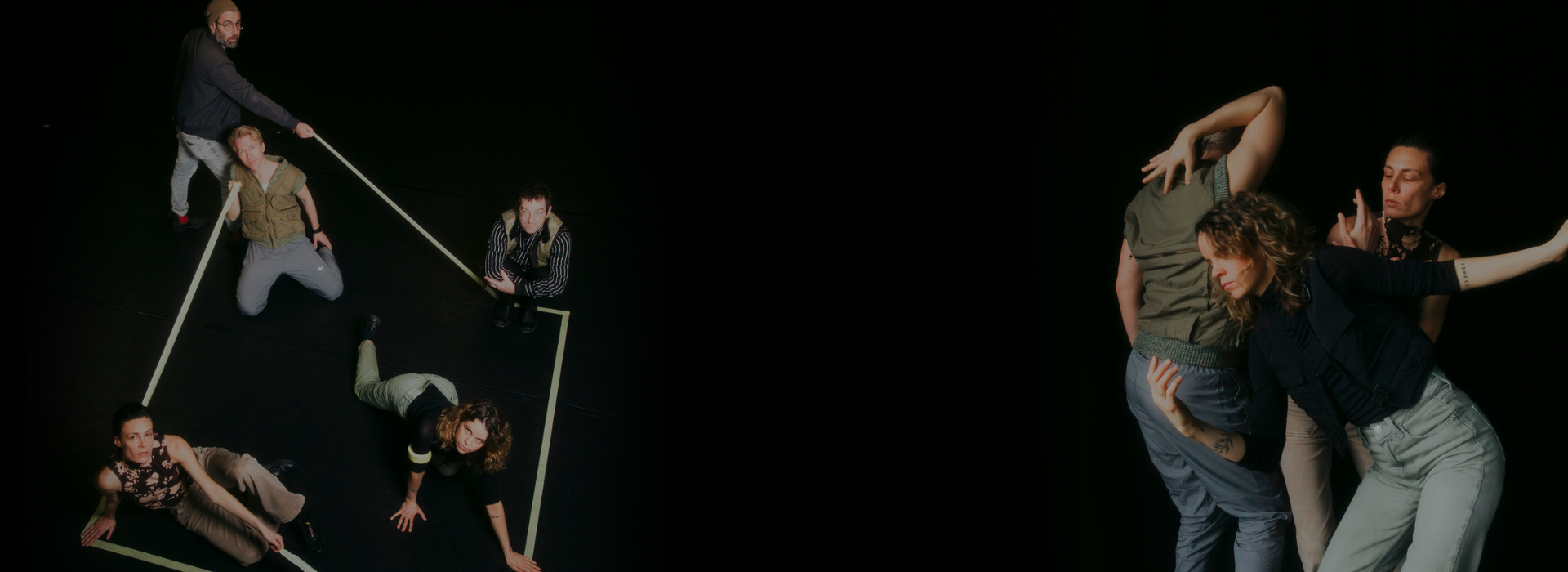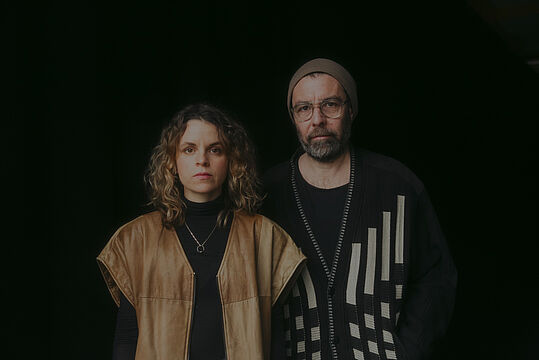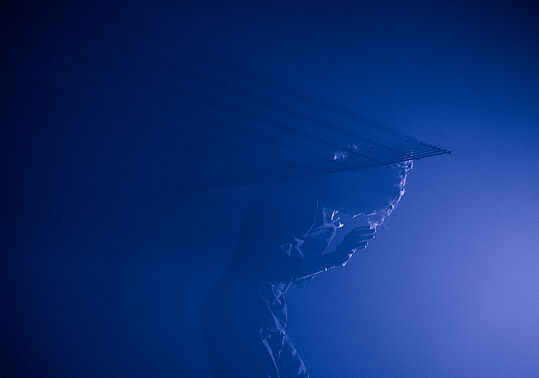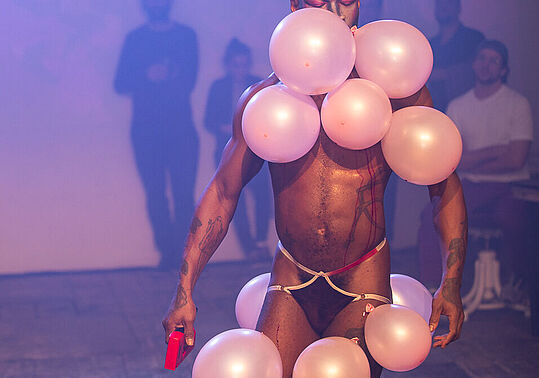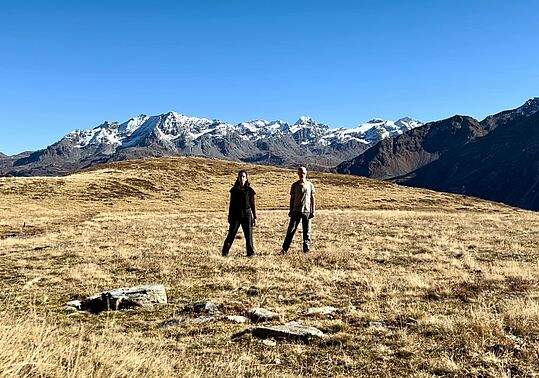The Power of Being Together in Uncertain Times
Lesezeit: ca. 5 Minuten
With Every body in a space, Karin Pauer and Aldo Giannotti examine the significance of assembly, collectivity and individual positioning in a time in which digital connections often replace physical ones. The work invites us to explore the tensions between the individual and the community and to experience the transformative power of togetherness. What does it mean to be together in a space? How do we influence each other? And what responsibility do we have for each other?
We spoke to the artists about their approaches, challenges and hopes.
Was there a particular moment, experience, or observation that inspired you to deal with the topics of community and collectivity?
Aldo Giannotti: These topics have been central to my practice for a long time. From a personal perspective, I think it’s a recurring question in life: how do we create a sense of belonging beyond familial bonds? How do we forge our own communities? In my work, I often attempt to initiate encounters that allow temporary communities to form—moments where people connect in ways they may not have expected. These encounters hold the potential for change, for seeing one another differently.
Karin Pauer: I am often deeply moved and inspired by the power of a unified collective. There is something profoundly human in witnessing empathy, solidarity, and the possibility of transformation when people come together. These moments, whether joyful or full of resistance, always feel like the seedbed for something larger than the sum of its parts.
«The act of gathering—bodies coming together in a space to share an experience—feels deeply human and urgently needed.»
In a time of societal division, where digital connections often replace physical ones, how does your work with "Every body in a space" address these challenges?
Karin Pauer: I think the ritual and institution of theatre hold immense potential. The act of gathering—bodies coming together in a space to share an experience—feels deeply human and urgently needed. In theatre, we not only witness a performance but also see through the eyes of those around us. This collective experience fosters empathy and a broader understanding of diverse perspectives. Despite feeling like an ancient and dated practice in today's digital age, theatre fulfills a profound human need to connect with others beyond our immediate circles. It’s a unique opportunity to create something meaningful and perhaps even hopeful during times of societal upheaval.
Aldo Giannotti: I completely agree. The square is a powerful metaphor in this context—a space where individuals can gather and connect while maintaining their individuality. It represents the act of assembling, of creating a shared presence. In the square, silence can transform into dialogue, isolation into solidarity. Through this work, we hope to offer an antidote to disconnection by demonstrating the transformative potential of simply being together, in the same place, at the same time.
What appeals to you about bringing normally hidden elements—like work platforms, technical equipment, or backstage labor—into the center of your performances?
Aldo Giannotti: Recently, I created a show at Kunstforum Bank Austria titled House of Constructs in collaboration with Karin, where we worked with making the invisible visible and exposing the "behind-the-scenes" aspects of art production. The technicians in institutions, for example —whether in a theatre or museum—are essential to making the work possible, yet their labor often goes unacknowledged in the business of illusion-making. I am deeply interested in exposing the real, in shining a light on the hidden labor and the people executing it, thereby questioning established hierarchies.
For me, connecting with the humans who make the work possible—whether technicians, museum guards, or office workers—forms the foundation of many of my ideas and artworks. In recent years, these collaborations have been some of the most enriching experiences of my practice. They also bring into focus the concept of social sustainability, which is becoming increasingly central to my work: recognizing and valuing the contributions of every individual in a collective endeavor and ensuring that these connections are equitable and meaningful.
Artistic practice can unite voices without erasing individuality. How does this idea manifest in "Every body in a space"?
Karin Pauer: Art has the power to hold contradictions. It’s a space where individual voices can coexist, overlap, and even clash without losing their essence. In this piece, we’ve created structures that allow for both unity and divergence. The square becomes a place where differences are not just tolerated but celebrated, where the tension between the individual and the collective becomes a source of energy and meaning.
Participation is central to your performance. How do you encourage audiences to engage actively, and what does this engagement reveal about community?
Karin Pauer: We start with gentle invitations. It’s about creating an atmosphere of trust, where people feel safe enough to slightly step outside their comfort zones. Over time the line between every body blurs, until the actions of every body in the space are equally affecting the performance. This process mirrors the dynamics of a community—it’s about showing up, making choices, and realizing that your presence matters.
Aldo Giannotti: Exactly. Participation isn’t about forcing people to act; it’s about giving them the freedom to choose. This choice is a metaphor for how we navigate society. Do we conform? Do we resist? Do we engage? The square—and the theatre—becomes a rehearsal space for these larger questions.
«We have to practice taking a stance—putting our bodies in these active positions.»
What would you like the audience to take away from "Every body in a space"?
Karin Pauer: I hope they leave with a sense of possibility—the possibility that assembly can be both joyful and urgent, that it can resist and imagine at the same time. In these turbulent times, we need to stay awake to the power of coming together. Whether it’s through collective euphoria or collective resistance, the act of gathering holds immense potential for change.
Aldo Giannotti: I think nowadays we are used to staying in our comfort zones. We often assume someone else will step in, will stand up for something in our name. But we have to practice taking a stance—putting our bodies in these active positions. We have to position ourselves clearly. Ultimately, I hope participants leave with questions: How do we inhabit shared spaces? What does it mean to stand together while standing apart? And perhaps most importantly, what responsibilities come with sharing these spaces with others?
Zu allen Artikeln

